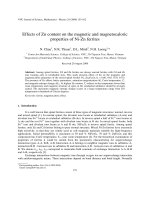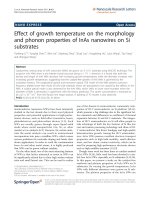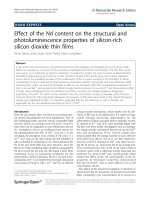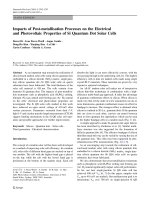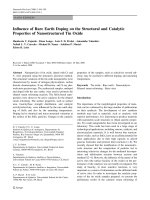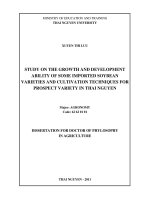Study on the physical and mechanical properties of ancient clay brick samples of Kathmandu valley, Nepal
Bạn đang xem bản rút gọn của tài liệu. Xem và tải ngay bản đầy đủ của tài liệu tại đây (1.14 MB, 18 trang )
TRIBHUVAN UNIVERSITY JOURNAL, VOL. 32, NO. 2, DECEMBER, 2018
1
STUDY ON THE PHYSICAL AND MECHANICAL
PROPERTIES OF ANCIENT CLAY BRICK
SAMPLES OF KATHMANDU VALLEY, NEPAL
Jagadeesh Bhattarai*
Dol Bahadur Ghale
Yagya Prasad Chapagain
Narendra Bahadur Bohara
Nijan Duwal
ABSTRACT
Physical and mechanical properties of seven ancient clay brick
samples of Kathmandu valley consisting of quartz, feldspars, spinel,
margarite, muscovite type of mica mineral and hematite were studied
using ASTM standards. All the brick samples used in this study have
the water absorption, apparent porosity and bulk density in the range
of 10-28 percent, 17-33 percent and 1.2-1.8 g/cm3, respectively, while the
compressive strength of all the brick samples is found to be in the range
of 5-23 MPa. The bulk density of the tile samples is found to be increased
with decreasing the water absorption and apparent porosity. The
compressive strength of all the clay brick samples can be correlated with
their physical properties. Consequently, durability of the ancient bricks
is directly influenced by their physical properties of water absorption,
apparent porosity and bulk density.
Keywords: Archaeological brick, water absorptivity, apparent
porosity, density, compressive strength, ASTM standards, fluxing
oxides, archaeologically important
INTRODUCTION AND OBJECTIVE
The clay brick is homogeneous, harder and stronger due to the
ceramic bond from the sintering phase of the silica and alumina clay
constituents and it was one of the fundamental structural building materials
in the Mesopotamian, Egyptian and Roman periods (Fernandes et al. 2010).
*
Dr. Bhattarai is Professor of Chimestry, Central Department of Chemistry,
Kirtipur, TU. Mr. Ghale is associated with Central Department of Chemistry,
Kirtipur, TU. Mr. Chapagain is associated with Department of Chemistry, TriChandra Campus, Kathmandu, TU. Mr. Bohara is associated with Department
of Chemistry. Mr. Duwal is associated with Department of Chemistry, St.
Xavier College, Kathmandu.
2
STUDY ON THE PHYSICAL AND MECHANICAL PROPERTIES ...
It is generally considered that the properties of such archaeological building
materials of clay brick are essentially depended on the quality of the raw
materials used for making it together with the manufacturing process
technology. The ancient brick manufacturing techniques was depended on
the supervisors and it was considered as the hereditary gifted knowledge
passed on to generations from their forefathers (Hasan 1999). This is the
main reason that the knowledge about the ancient clay brick materials
and their application techniques which were so successfully used in the
past has now disappeared without any documentation in our part of the
world, because the properties of such types of clay bricks depend on their
mineralogical compositions, manufacturing process and firing temperature
(Bordia & Camacho-Montes 2012).
The fired clay bricks are extremely durable and hence, there have
been numerous archaeological structural buildings standing for centuries as
a testimony of the survival of the clay-based fired bricks. The main factor to
manufacture these bricks is the clay raw material types used and the firing
temperature during their production, because both of these affect the quality
and durability of bricks (Mostaghelchi et al. 2013; Rasmussen et al. 2012;
Dunham et al. 2001; Dondi et al. 1999). A large number of studies have
been reported about the ancient brick structures and materials to foster their
cultural and economic importance in different parts of the world (Šarić et
al. 2018; Amadori et al. 2017; Shu et al. 2017; Bartz & Chorowska 2016;
Oguz et al. 2014; Fernandes & Lourenço 2007; Cardiano et al. 2004; Elert
et al. 2003; López-Arce et al. 2003; Paama et al. 2000).
It is said that the durability (i. e., mechanical strength) of the clay
bricks depends mainly on their mineralogical composition and physicosintering properties (Bordia & Camacho-Montes 2012). The mineralogical
and physical properties and mechanical strength of the fired clay bricks are
generally interrelated to each others. It is reported that the firing temperature
is one of the key factor to modulate the physical, sintering and mechanical
properties of different types of brick samples (Ajala et al. 2017a, 2017b;
Velraj et al. 2009; Karaman et al. 2006), but not the firing rate on kaolinite
based ceramics (Njoya et al. 2017). Different physico-sintering properties
(i. e., water absorption capacity, apparent porosity, apparent density, bulk
density and so on) of clay bricks and their mechanical properties were
investigated at different firing temperatures and the brick sample fired at
1100 °C showed the best mechanical properties (Martin-Marquez et al.
2010; Ghorbel et al. 2008; Yongue-Fouateu et al. 2016; Johari et al. 2010).
TRIBHUVAN UNIVERSITY JOURNAL, VOL. 32, NO. 2, DECEMBER, 2018
3
In general, water absorption capacity, apparent porosity, bulk density are
considered to be most important physico-sintering properties of all types
bricks while the compressive strength is one of the important mechanical
properties. All these physico-sintering and mechanical properties are
reported to be inter-related to each other’s and they affect the durability of
all types of bricks even the archaeological clay brick samples.
The preservation of such archaeologically important ancient clay
bricks has given rise to a considerable interest recently by archaeologists,
architects, engineers and scientists, because the archaeological buildings
needs to be restored with substitution of bricks when they damage. A good
characterization of such archaeological clay brick specimens gives us a
possibility to predict advance the chemico-mineralogical phases, physicosintering and mechanical behavior of the new formed building system. To
learn about the historical understanding is not just to analyze and preserve
such archaeological objects but also to investigate and understand the
knowledge and skills used to produce and use them (Vandiver 2001).
The durability assessment of different types of clay bricks is mainly
based on their technical physico-sintering and mechanical properties.
However, such technical properties of the archaeological clay brick
samples of Kathmandu valley are not reported in scientific communities,
although mineralogy of the archaeological bricks (Ghale et al. 2018), fired
clay bricks at different temperatures (Bohara et al. 2018) and ceramic tiles
(Buthathoki et al. 2018a, 2018b) were recently reported by some of the
present researchers in Nepal. It was reported that the mineralogical phases
existed in the archaeological clay brick samples collected from Kathmandu
valley were identified as quartz, feldspars, spinel, muscovite type of mica
mineral and hematite, and such clay bricks were considered to be fired at
900-1000 °C for their production (Ghale et al. 2018). Considering these
facts, the present research work was focused to carry impact assessments
on three different physico-sintering properties of water absorption capacity,
apparent porosity, bulk density and one mechanical property of the
compressive strength of nine archaeologically important ancient clay brick
samples using ASTM Standards (ASTM C20-00 2015; ASTM C142415 2015) to know relation between the physico-sintering and mechanical
properties of the ancient clay bricks.
4
STUDY ON THE PHYSICAL AND MECHANICAL PROPERTIES ...
methodology
The archaeologically important seven ancient brick samples were
collected from the relics of Kathmandu Tower-Dharahara, Basantapur
Durbar square, Balgopaleshwor Temple- Ranipokhari, Clock Tower
building- Ghantaghar, Tripureshwor (Department of Consular Services),
and Baghbhairav Temple and Pangaa of Kirtipur in this research work those
were distracted by the great earthquake- April 2015, with the permission
of concerned authorities. The detail descriptions of these eight clay brick
sample specimens are summarized in Table 1 and the photographs of all
these clay brick samples are shown in Fig. 1 (Ghale 2018).
Fig. 1: Photographs of ancient clay brick samples of Kathmandu valley
Source: Ghale 2018.
TRIBHUVAN UNIVERSITY JOURNAL, VOL. 32, NO. 2, DECEMBER, 2018
5
Table 1: Description of the archaeologically important clay brick samples
used in this study 2018.
Place of Collection
Dharahara (Kathmandu Tower)
Basantapur Durbar Square
Ghantaghar (Clock Tower)
Balgopaleshwor Temple ( Ranipokhari)
Baghbhairav Temple-Kirtipur
Tripureshwor-Dept. Consular Services
Paanga-Kirtipur
Sample Code
DB-1
DB-2
DB-3
DB-4
DB-5
DB-6
DB-7
Type
Ancient Brick
Ancient Brick
Ancient Brick
Ancient Brick
Ancient Brick
Ancient Brick
Ancient Brick
It is meaningful to mention here that the mineralogical phase of
these seven ancient clay brick samples was reported to be consisted mainly
of quartz, feldspars, spinel, margarite, hematite and muscovite type of
mica minerals from previous works (Ghale et al. 2018). In this study, the
physical properties of water absorption capacity, apparent porosity and bulk
density of the analyzed clay brick samples were estimated using following
equations (1), (2) and (3) (ASTM C20-00 2015), respectively, were D is the
weight of brick sample in dry condition (g), S is the weight of brick sample
in saturated condition (g) and V is volume of outer sides (cm3) of the brick
sample specimens. The details about the estimation of these three physicosintering properties were described elsewhere (Ghale 2018).
S-D
Water Absorption (%) =
× 100
(1)
D
S-D
Apparent Porosity (%) =
× 100
(2)
V
D
Bulk Density (g/cm 3 ) =
(3)
V
The mechanical property of the compressive strength of the seven
ancient clay brick samples was estimated in accordance with ASTM
standards (ASTM C1424-15 2015) using the RAM DIA 222-2 mm with
maximum load of 2000 KN compression testing machine available at the
Central Material Testing Laboratory, Department of Civil Engineering
of Pulchowk Engineering Campus, Tribhuvan University, Lalitpur using
equation (4) as given below. The details about the estimation of the
compressive strength of the seven ancient brick samples were described
elsewhere (Bohara et al. 2018).
Maximum load at failure (N)
Compressive Strength (N/mm 2 ) =
(4)
Average area of bed face (mm 2 )
6
STUDY ON THE PHYSICAL AND MECHANICAL PROPERTIES ...
RESULTS AND DISCUSSION
The physico-sintering and mechanical properties of the clay brick
samples depend on the optimum conditions maintained at the time of their
manufacturing. Basic physico-sintering (i.e., water absorption capacity, bulk
density and apparent porosity) and mechanical (i.e., flexural or compressive
strength) properties act as the quality control and durability of the clay
bricks, which ultimately depend on the phase and chemical compositions
of their raw materials. Figure 2 shows the changes in the water absorption
capacity of the archaeologically important seven ancient clay brick samples
from historical places of Kathmandu valley. It is clearly shown from the
figure that all the analyzed clay brick samples show the water absorption
capacity in the range of 9.7-27.7 percent (Fig. 2). Only one brick sample
of Clock Tower (i.e., DB-3) show the water absorption capacity less than
10 percent, while two brick samples of DB-2 and DB-5 show more than 25
percent of water absorption capacity as depicted in Fig. 2.
Fig. 2: Water absorption capacity of the archaeological clay brick samples
TRIBHUVAN UNIVERSITY JOURNAL, VOL. 32, NO. 2, DECEMBER, 2018
7
The water absorption capacity is one of the important criteria for
representing the quality and strength of the clay bricks. A lower value of
the water absorption capacity is always desired for good quality of clay
bricks. The differences in the mineralogical phases of the raw materials
of the ceramic body controls the water absorption capacity and the low
water absorption value of the brick sample should be due to the presence
of high amounts of clay minerals content in their composition with high
densification, low porosity and high bulk density. Therefore, the apparent
porosity (Fig. 3) of the brick samples used in this study is found to be
decreased with decreasing the water absorption capacity (Fig. 2). It is clearly
shown from the Fig. 3 that all the analyzed ancient clay brick samples show
the apparent porosity in the range of 16.9-33.2 percent. Among these seven
archaeologically important brick samples, DB-3 (i.e., Clock Tower) show
the apparent porosity less than other six brick samples, while four brick
samples of DB-2, DB-5, DB-6 and DB-7 show its values between 31.4 and
33.2 percent as shown in Fig. 3.
Similarly, the estimated result of the bulk density of all seven
archaeological clay brick samples of Kathmandu valley is shown in Fig. 4.
It is clear from the figure that brick samples of DB-1, DB-3 and DB-4 show
the bulk density in the range of 1.53-1.75 g/cm3, while remaining four brick
samples show it between 1.2 and 1.5 g/cm3 as shown in Fig. 4. It is generally
considered that the clay brick samples having low water absorption capacity
and apparent porosity have high bulk density and expected high mechanical
strength also.
Furthermore, there is a good correlation between the water
absorption capacity, apparent porosity and bulk density of all analyzed
clay bricks. Both the water absorption and apparent porosity of the brick
samples are found to be decreased with increasing the bulk density as
depicted in Fig. 5. These results are mostly supported by the facts that the
low density value observed for the brick samples is directly related to their
high apparent porosity and high water absorption capacity with low particle
packing in the brick bodies. In general, it is believed that the fired bricks
have expected high bulk density and mechanical strength of compressive
strength with low water absorption capacity and apparent porosity.
8
STUDY ON THE PHYSICAL AND MECHANICAL PROPERTIES ...
Fig. 3: Apparent Porosity of the archaeological clay brick samples
Fig. 4: Bulk density of the archaeological clay brick samples
TRIBHUVAN UNIVERSITY JOURNAL, VOL. 32, NO. 2, DECEMBER, 2018
9
Fig. 5: Relation between the water absorption as well as apparent porosity
with the bulk density of the archaeological clay brick samples
Different techniques are discussed for testing of various mechanical
properties like compressive strength (ASTM C1424-15 2015), flexural
strength (ASTM C1161-13 2013), static fracture toughness (ASTM
C1421-16 2016) and so on. However, it is generally practice to estimate
the compressive strength of brittle ceramic bodies like brick samples and
hence this study was focused to measure the compressive strength of the
archaeologically important seven brick samples collected from different
historical sites of Kathmandu valley to correlate it with other physical
properties as describe above. Figure 6 shows the result of the estimated
compressive strength of the collected seven ancient brick samples from
historically important places of Kathmandu valley.
10
STUDY ON THE PHYSICAL AND MECHANICAL PROPERTIES ...
Fig. 6: Compressive strength of the archaeological clay brick samples
It is clear from the figure that one brick sample of DB-2 of
Basantapur Darbar Square shows the lowest compressive strength of about
5 MPa only among seven samples used in this study which is assumed to
be low compressive strength value than that of the standard brick samples.
Although, remaining other six brick samples have the compressive strength
in the range of 10.4-22.7 MPa as shown in Fig. 6.
On the other hand, both the water absorption capacity and the
apparent porosity of these bricks are deleterious to the mechanical
properties of ceramic bodies like brick samples due to the following two
reasons: firstly, the pores reduce the cross-sectional area across in which
a load is applied and secondly, they also act as stress concentrators; for
example, an applied tensile stress is amplified by a factor of 2 for an
isolated spherical pore (Coble and Kingery 1956). It is generally considered
that high mechanical strength of the ceramic bodies like clay bricks is also
related with their physical properties like low water absorption capacity,
low apparent porosity and high bulk density.
The influence of porosity on the mechanical properties of ceramic
bodies is rather dramatic; for example, it is not uncommon that 10 percent
volume porosity will decrease the flexural strength by 50 percent from
the measured value for the nonporous materials. It was reported that the
flexural strength decreased exponentially with volume fraction porosity
TRIBHUVAN UNIVERSITY JOURNAL, VOL. 32, NO. 2, DECEMBER, 2018
11
experimentally (Callister 2010) and now we considered that such relations
could be explained for compressive strength of the brick samples like flexural
strength. There is a good correlation between the compressive strength
with all these three types of physical properties (i.e., water absorption,
apparent porosity and bulk density) of all the analyzed archaeologically
important seven clay brick samples used in this study as shown in Figs 7-9.
The compressive strength of the brick samples is found to be increased
exponentially with decreasing the water absorbtivity and apparent porosity
exponentially as shown in Fig. 7, although the compressive strength of the
brick samples is increased with increasing their bulk density as shown in
Fig. 8.
Fig. 7: The influence of the water absorption and apparent porosity on the
compressive strength of the archaeologically important brick samples
12
STUDY ON THE PHYSICAL AND MECHANICAL PROPERTIES ...
Fig. 8: Relation between the compressive strength and bulk density of the
archaeologically important brick samples
The compressive strength of the brick samples is directly related
with the bulk density. Consequently, it can be said that efforts need to focus
on decreasing both the water absorbtivity as well as the apparent porosity
and on increasing the bulk density in order to improve the mechanical
properties of the clay brick samples, because these physical properties of
water absorbtivity, apparent porosity and bulk density are largely responsible
for the betterment of all ceramic bodies like clay bricks. Moreover, a good
correlation between compressive strength, water absorption, apparent
porosity and bulk density of the brick samples is shown in Fig. 9 and the
estimated values of these properties are tabulated in Table 2.
TRIBHUVAN UNIVERSITY JOURNAL, VOL. 32, NO. 2, DECEMBER, 2018
13
Fig. 9: The influence of the water absorption, apparent porosity and bulk
density on the compressive strength of the archaeologically important brick
samples
Table 2: Description of the archaeologically important clay brick samples
used in this study
Sample
Name
DB-1
DB-2
DB-3
DB-4
DB-5
DB-6
DB-7
Water
Absorption
(%)
16.05
27.72
9.70
13.90
26.62
23.10
21.27
Apparent
Porosity
(%)
24.56
33.23
16.92
22.80
32.69
32.07
31.44
Bulk
Density (g/
cm3)
1.53
1.20
1.74
1.64
1.23
1.39
1.48
Compressive
Strength
(MPa)
16.41
5.00
22.75
15.80
10.35
11.59
12.09
14
STUDY ON THE PHYSICAL AND MECHANICAL PROPERTIES ...
CONCLUSION
The present research work was focused to study the physical and
mechanical properties of seven archaeological clay bricks of Kathmandu
valley for their quality assessments using ASTM standards and the following
conclusions are drawn from above results and discussion.
It is found A good correlation between the physical properties of
water absorption, apparent porosity and bulk density with the mechanical
property of compressive strength was found for brick samples of seven
historically important places of Kathmandu valley.
All the ancient clay brick samples used in this study have low water
absorption as well as apparent porosity and high bulk density which are
responsible for their high compressive strength and vice versa.
The water absorption, apparent porosity and bulk density are
largely responsible for the betterment of the mechanical property of
compressive strength of the brick samples used in this study and hence
efforts need to focus on decreasing both the water absorption capacity and
apparent porosity with increasing the bulk density in order to improve the
mechanical properties of the bricks.
ACKNOWLEDGEMENTS
Authors would like to acknowledge University Grants CommissionNepal (UGC-Nepal) for providing the UGC Faculty Research Grant2072/073 to conduct this research work.
REFERENCES
Ajala, A.J., Badarulzaman, N.A. and Aramjat, A.B. (2017b). Influence
of sintering temperatures on physico-mechanical properties and
microstructure of refractory fireclay bricks. International Journal
of Engineering and Technology 8(6): pp. 2588-2593. Retrived form
/>Ajala, A.J.; Badarulzaman, N.A. and Aramjat, A.B. (2017a). Impact of
sintering temperatures on microstructure, porosity and mechanical
strength of refractory brick. Materials Science Forum 888: pp.
66-70. Retrived form />MSF.888.66
Amadori, M. L., Pallante, P., Fermo, P., Emami, M., Chaverdi, A. A.,
Callieri, P. And Matin, E. (2017). Advances in Achaemenid brick
manufacturing technology: Evidence from the monumental gate at
TRIBHUVAN UNIVERSITY JOURNAL, VOL. 32, NO. 2, DECEMBER, 2018
15
Tol-e Ajori (Fars, Iran). Applied Clay Science 152: pp. 131-142.
Retrived form />ASTM C1161-13 (2013). Standard test method for flexural strength of
advanced ceramics at ambient temperature, In Annual Book of
ASTM Standards, ASTM International, West Conshohocken, USA.
Retrived form />ASTM C1421-16 (2016). Standard Test Methods for Determination of
Fracture Toughness of Advanced Ceramics at Ambient Temperature,
In Annual Book of ASTM Standards, ASTM International, West
Conshohocken, USA. Retrived form />C1421-16
ASTM C1424-15 (2015). Standard Test Methods for Monotonic Compressive
Strength of Advanced Ceramics at Ambient Temperature.
Annual Book of ASTM Standards, ASTM International, West
Conshohocken, USA. Retrived form />C1424-15
ASTM C20-00 (2015). Standard Test Methods for Apparent Porosity, Water
Absorption, Apparent Specific Gravity and Bulk Density of Burned
Refractory Brick and Shapes by Boiling Water. Annual Book of
ASTM Standards, ASTM International, West Conshohocken, USA.
Retrived form />Bartz, W. and Chorowska, M. (2016). Mineralogy and technology of bricks
used for the construction of the XII century ducal castle on the
island of Ostrów Tumski, Wrocław (SW Poland). Geoscience
Records 2(1): pp. 4–16. Retrived form />georec-2016-0002
Bohara, N. B., Bhat, L. B., Ghale, D. B., Duwal, N. and Bhattarai, J. (2018).
Investigation of the firing temperature effects on clay brick sample;
part-I: mineralogical phase characterization. Bibechana 16: pp.
122-130 (2018). Retrived form />v16i0.21319
Bordia, R. K. and Camacho-Montes, H. (2012). Sintering: Fundamentals and
Practice in Ceramics and Composites Processing Methods, Part-1:
Densification. Pp. 3-42. In N. P. Bansal and A. R. Boccaccini((eds),
1st edition, The American Ceramic Society, John Wiley and Sons,
Inc.
Budhathoki, P., Duwal, N. and Bhattarai, J. (2018a). Investigation on
physico-sintering and mechanical properties of clay tiles Available
in Kathmandu valley of Nepal. Asian Journal of Chemistry
30(11): pp. 2515-2530. Retrived form />ajchem.2018.21509
16
STUDY ON THE PHYSICAL AND MECHANICAL PROPERTIES ...
Budhathoki, P., Paudal, P., Oli, R.R., Duwal, N. and Bhattarai, J. (2018b).
Assessment on the characterization of mineralogical phase of
ceramic tiles available in Kathmandu valley (Nepal) using XRD
and FTIR analyses. International Journal of Applied Science
and Biotechnology 6(3): pp. 238-243. Retrived form https://doi.
org/10.3126/ijasbt.v6i3.21171
Callister W. D., Jr. (2010). Materials Science and Engineering. John Willey
and Sons, Hoboken, USA.
Cardiano, P., Ioppolo, S., Stefano, C., Pettignano, A., Sergi, S. and Piraino,
P. (2004). Study and characterization of the ancient bricks of
monastery of “San Filippo di Fragalà” in Frazzanó (Sicily).
Analytica Chimica Acta 519(1): pp. 103-111. Retrived form https://
doi.org/10.1016/j.aca.2004.05.042
Coble R. L. and Kingery W. D. (1956). Effect of porosity on physical
properties of sintered alumina. Journal of the American Ceramic
Society 39: pp. 377-385. Retrived form />j.1151-2916.1956.tb15608.x
Dondi, M., Marsigli, M. and Venturi, L. (1999). Microstructure and
mechanical properties of clay bricks: comparison between fast firing
and traditional firing. British Ceramics Transactions 98(1): pp. 1218. Retrived form />Dunham, A. C., McKnight, A.S. and Warren, I. (2001). Mineral assemblages
formed in Oxford clay fired under different time-temperature
conditions with reference to brick manufacture. Proceedings of the
Yorkshire Geological Society 53(3): pp. 221-230. Retrived form
/>Elert, K., Cultrone, G., Navarro, C. R. and Pardo, E. S. (2003). Durability
of bricks used in the conservation of historic buildings-influence
of composition and microstructure. Journal of Cultural Heritage
4: pp. 91-99. Retrived form />Fernandes, F. and Lourenço, P. B. (2007). Evaluation of the compressive
strength of ancient clay bricks using microdrilling. Journal of
Materials in Civil Engineering 19(9): pp. 791-800. Retrived form
doi:10.1061/(ASCE)0899-1561(2007)19:9(791)
Fernandes, F. M., Lourenço, P. B. and Castro, F. (2010). Ancient Clay
Bricks: Manufacture and Properties, Chapter-3. Pp. 29-48 in Dan
M.B., Přikryl R., Török Á. (eds). Materials, Technologies and
Practice in Historic Heritage Structures. Springer, Dordrecht.
Retrived form />
TRIBHUVAN UNIVERSITY JOURNAL, VOL. 32, NO. 2, DECEMBER, 2018
17
Ghale, D. B. (2018). Investigation on the Moneralogy, Physical and
Mechnical Properties of Ancient Bricks of Kathmandu Valley. M.
Sc. Dissertation. Central Department of Chemistry, Tribhuvan
University, Kathmandu, pp. 57+viii.
Ghale, D. B., Bohara, N. B., Duwal, N. And Bhattarai, J. (2018). Investigation
on the mineralogical phase of ancient brick samples of Kathmandu
valley (Nepal) using XRD and FTIR analysis. Rasaayan Journal of
Chemistry (in press).
Ghorbel, A., Fourati, M. and Bouaziz, J. (2008). Microstructural evolution and
phase transformation of different sintered kaolins powder compacts.
Materials of Chemistry and Physics 112: pp. 876-885. Retrived
form />Hasan, A. (1999). The Art and Science of Brick Making, 1st edition. Pp.
1-10.
Johari, I., Said, S., Hisam, B., Bakar, A. and Ahmad, Z.A. (2010). Effect
of the change of firing temperature on microstructure and physical
properties of clay bricks from Beruas (Malaysia). Science of
Sintering 42(2): pp. 245-254 (2010). Retrived form https://doi.
org/10.2298/SOS1002245J
Karaman, S., Ersahin, S. and Gunal, H. (2006). Firing temperature and firing
time influence on mechanical, physical properties of clay bricks.
Journal of Science and Industrial Research 65(2): pp. 153-159.
Retrived form />López-Arce, P., Garcia-Guinea, J., Gracia, M. and Obis, J. (2003). Bricks in
historical buildings of Toledo city: characterization and restoration.
Materials Characterization 50(1): pp. 59-68. Retrived form https://
doi.org/10.1016/S1044-5803(03)00101-3
Martin-Marquez, J., Rincon, J.M. and Romero, M. (2010). Effect of
microstructure on mechanical properties of porcelain stoneware.
Journal of the European Ceramic Society 30(15): pp. 3063-3069.
Retrived form />Mostaghelchi, M., Zahiri, R., Miremad, S. H. and Ebadi, A. G. (2013).
Use of mica mineral powder in bricks industry to improve the
performances. Asian Journal of Chemistry 25(16): pp. 9144-9148.
Retrived form />Njoya, D., Tadjuidje, F.S., Ndzana, E.J.A., Pountouonchi, A., TessierDoyen, N. And Lecomte-Nana, G. (2017). Effect of flux content
and heating rate on the microstructure and technological properties
of Mayouom (Western-Cameroon) kaolinite clay based ceramics.
Journal of Asian Ceramic Societies 5(4): pp. 422-426. Retrived
form />
18
STUDY ON THE PHYSICAL AND MECHANICAL PROPERTIES ...
Oguz, C., Turker, F. and Kocka, N. U. (2014). Construction materials used
in the historical Roman Era bath in Myra. Scientific World Journal
2014, Article ID 536105, pp. 1-9. Retrived form .
org/10.1155/2014/536105
Paama, L., Pitkanen, I. and Peramaki, P. (2000). Analysis of archaeological
samples and local clays using ICP-AES, TG–DTG and FTIR
techniques. Talanta 51(2): Pp. 349-357. Retrived form https://doi.
org/10.1016/S0039-9140(99)00281-7
Rasmussen, K. L., De La Fuente, G. A., Bond, A. D., Matheesen, K. K.
and Vera, S. D. (2012). Pottery firing temperatures: a new method
for determining the firing temperature of ceramics and burnt clay.
Journal of Archaeological Science 39(6): pp. 1705-1716. Retrived
form />Šarić, K., Bikić, V. and Erić, S. (2018). Microstructural, mineralogical
and petrographical characteristics of the medieval ceramics
from the Studenica monastery (UNESCO world heritage
site): Implications on the pottery technology and provenance of the
raw material. Microscopy and Microanalysis 24(6): pp. 744-761.
Retrived form />Shu, C.X., Cantisani, E., Fratini, F., Rasmussen, K.L., Rovero, L, Stipo,
G. and Vettori S. (2017). China’s brick history and conservation:
laboratory results of Shanghai samples from 19th to 20th century.
Construction and Building Materials 151: pp. 789-800. Retrived
form />Vandiver, P. (2001). The role of materials research in ceramics and
archaeology. Annual Review of Materials Research 31: pp. 373-385.
Retrived form />Velraj, G., Janaki, K., Musthafa, A.M. and Palanivel, R. (2009). Spectroscopic
and porosimetry studies to estimate the firing temperature of some
archaeological pottery shreds from India. Applied Clay Science
43(3-4): pp. 303-307. Retrived form />clay.2008.09.005
Yongue-Fouateu, R., Ndimukong, F., Njoya, A., Kunyukubundo, F. And
Mbih, P.K. (2016). The Ndop plain clayey materials (Bamenda
area- NW Cameroon): Mineralogical, geochemical, physical
characteristics and properties of their fired products. Journal of
Asian Ceramic Societies 4(3): pp. 299-308. Retrived form https://
dx.doi.org/10.1016/j.jascer.2016.05.008


